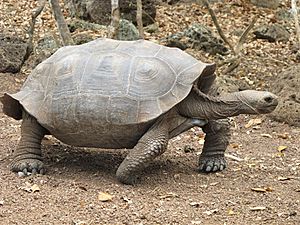San Cristóbal giant tortoise facts for kids
Quick facts for kids San Cristóbal giant tortoise |
|
|---|---|
 |
|
| Conservation status | |
| Scientific classification |
|
| Kingdom: | Animalia |
| Phylum: | Chordata |
| Class: | Reptilia |
| Order: | Testudines |
| Suborder: | Cryptodira |
| Family: | Testudinidae |
| Genus: | Chelonoidis |
| Species: | |
| Subspecies: |
C. n. chathamensis
|
| Trinomial name | |
| Chelonoidis niger chathamensis (Van Denburgh, 1907)
|
|
| Synonyms | |
|
|
The San Cristóbal giant tortoise (also known as the Chatham Island giant tortoise) is a special kind of Galápagos tortoise. It lives only on San Cristóbal Island in the famous Galápagos Islands. This tortoise is a subspecies called Chelonoidis niger chathamensis.
The Tortoise's Story: Past and Present
For a long time, people hunted these tortoises a lot. This caused their numbers to drop greatly across the island. Wild donkeys also trampled their nests, and wild dogs ate their baby tortoises. These problems made the tortoise population very small.
But people started to help! In the 1970s, fences were put around nests to protect them. Dogs were also removed from the island. These efforts helped the tortoise population start to grow again.
Before humans arrived, there were about 24,000 of these tortoises. By the 1970s, their numbers had dropped to only 500 to 700 individuals. Thanks to conservation efforts, a count in November 2016 showed a great recovery. About 6,700 tortoises were found. This included around 2,700 adult tortoises and 3,750 younger ones.
Places like the Galapaguera of Cerro Colorado were created. These are special breeding centers. They help endangered Galápagos tortoises have babies safely. Once the young tortoises are old enough, they are released back into their natural homes. This helps wild populations grow stronger.
What Does This Tortoise Look Like?
The San Cristóbal giant tortoise has a wide, black shell. Its shell shape is a mix between two types: saddle-backed and domed. Adult male tortoises often have a more saddle-backed shell. This means it curves up in the front, like a saddle. Female tortoises and young males have shells that are wider in the middle and more rounded, like a dome.
There used to be another type of this tortoise. It had a flatter shell and lived in the wetter, higher parts of the island. This area was changed a lot when people first settled there. Sadly, this flatter-shelled tortoise is now extinct.
See also
- In Spanish: Tortuga gigante de San Cristóbal para niños


